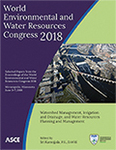World Environmental and Water Resources Congress 2018
Numerical Modeling of the Lake Water Quality and Upland Watershed Loads
Publication: World Environmental and Water Resources Congress 2018: Watershed Management, Irrigation and Drainage, and Water Resources Planning and Management
ABSTRACT
This paper presents a technical approach to link the watershed model and surface water quality model to study the effect of pollutant loads from upland watershed on the water quality of the receiving water body. The AnnAGNPS watershed model, developed at the USDA ARS, National Sedimentation Laboratory (NSL), is applied to simulate the loads of water, sediment, and nutrients from upland watersheds. In this model, the effects of land use/land cover, soil properties, climate, agriculture management, etc. on the watershed loads are considered. The computed results are used as boundary conditions for CCHE_WQ, a water quality model developed at the National Center for Computational Hydroscience and Engineering (NCCHE), to simulate the water quality concentration in water bodies. In this model, the effects of sediment on the water quality constituents are considered, and the distributions of nutrients, chlorophyll, and dissolved oxygen in the water body can be obtained. This technical approach is tested using Beasley Lake watershed in the Mississippi Delta as a study site. The lake water quality is monitored by NSL, and the measured data is used to calibrate and validate the numerical model. In this lake, sediment concentration is relatively high, so the sediment-associated water quality processes need to be taken into account. This research provides a useful tool to assess long term impacts of watershed nutrient and sediment loads on the water quality of the receiving water bodies.
Get full access to this chapter
View all available purchase options and get full access to this chapter.
ACKNOWLEDGEMENTS
This work is a result of research sponsored by the USDA Agriculture Research Service under Specific Research Agreement No. 58-6408-1-609.
REFERENCES
Bubba, M.D., Arias, C.A. and Brix, H. (2003). Phosphorus adsorption maximum of sands for use as media in subsurface flow constructed reed beds as measured by the Langmuir isotherm. Water Research, 37: 3390–3400.
Bingner, R. L. and F. D. Theurer. 2001. AnnAGNPS: Estimating Sediment Yield by Particle Size for Sheet & Rill Erosion. Proceedings of the Seventh Interagency Sedimentation Conference, Reno, NV, 25-29 March 2001. Vol. 1 (I):1–7.
Bingner, R. L. and F. D. Theurer 2005. AnnAGNPS Technical Processes, Available at http://www.ars.usda.gov/SP2UserFiles/Place/60600505/AGNPS/PLModel/Document/Tech_Doc.PDF. Accessed in Nov. 2014.
Chao, X., Jia, Y., Shields, F. D. Jr., Wang, S.S.Y. and Charles M. Cooper (2010), Three-Dimensional Numerical Modeling of Water Quality and Sediment-Associated Processes with Application to a Mississippi Delta Lake, Journal of Environmental Management, 91(7), 1456–1466.
Chapra, S.C., 1997. Surface Water-Quality Modeling, The Mcgraw-Hill Companies, Inc, New York.
Licciardello, F., D. A. Zema, S. M. Zimbone, and R. L. Bingner. 2007. Runoff and soil erosion evaluation by the AnnAGNPS model in a small Mediterranean watershed. Transactions of the ASABE 50: (5)1585–1593.
Locke, M.A. (2004). Mississippi Delta Management Systems Evaluation Area: Overview of water quality issues on a water-shed scale. In Water quality assessments in the Mississippi Delta: Regional solutions, national scope. M.T. Nett, M.A. Locke, and D.A. Pennington, eds. ACS Symposium Ser. 877, pp. 1–15.
Shrestha, S., S. Babel Mukand, A. Das Gupta, and F. Kazama. 2006. Evaluation of annualized agricultural nonpoint source model for a watershed in the Siwalik Hills of Nepal. Environ. Modelling and Software 21(7): 961–975.
Rebich, R.A and Knight, S. S. (2001). The Mississippi Delta Management Systems Evaluation Area Project, 1995-99. Missis-sippi Agriculture and Forestry Experiment Station, Information Bulletin 377, Division of Agriculture, Forestry and Veteri-nary Medicine, Mississippi State University.
Romero, J.R. et al. (2003). Computational aquatic ecosystem dynamics model: CAEDYM v2, Science Manual, University of Western Australia.
USDA Soil Conservation Service (1985). National Engineering Handbook. Section 4: Hydrology. Washington DC: USDA.
Wool, T.M., et al. (2001). Water Quality Analysis Simulation Program (WASP) version 6 User’s Manual, USEPA, Atlanta, GA.
Yuan, Y. Locke, M.A and Bingner, R.L. (2008), Annualized Agricultural Non-Point Source model application for Mississippi Delta Beasley Lake watershed conservation practices assessment, Journal of Soil and Water Conservation 63(6):542–551.
Information & Authors
Information
Published In
World Environmental and Water Resources Congress 2018: Watershed Management, Irrigation and Drainage, and Water Resources Planning and Management
Pages: 532 - 540
Editor: Sri Kamojjala, Las Vegas Valley Water District
ISBN (Online): 978-0-7844-8140-0
Copyright
© 2018 American Society of Civil Engineers.
History
Published online: May 31, 2018
Authors
Metrics & Citations
Metrics
Citations
Download citation
If you have the appropriate software installed, you can download article citation data to the citation manager of your choice. Simply select your manager software from the list below and click Download.
